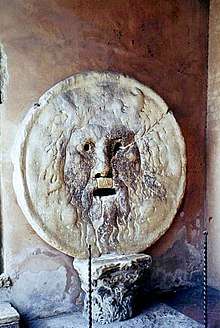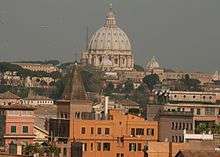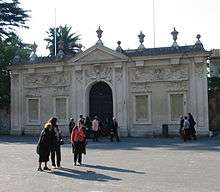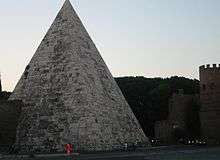Rome/Aventino-Testaccio
Aventino is named for the hill which rises up near the Tiber river and is one of the legendary seven hills of Rome. Diagonally opposite at the end of Circus Maximus is the Celian Hill, another of the seven hills. Testaccio is an area to the southwest of Aventino along the bank of the Tiber and is named for the eighth hill of Rome, a man made hill that was built from discarded pot amphorae (testae) in Roman times. In Testaccio you can find great traditional Roman restaurants, and at night the zone is filled with discos.

Aventino and Testaccio are neighborhoods of Rome.
Get in
Easy access to Aventino from most areas of Rome. From Termini area take a bus to Piazza Venezia and walk from there to reach Piazza Bocca della Verità.
Testaccio is a short walk from the metro station 🌍 Piramide B and there is also a metro line B station at the end of Circus Maximus. Near Piramide Metro station is Ostiense railway station, with regular connections to and from Fiumicino Airport. From Piramide you can also get trains to Ostia.
See
Aventine

- 🌍 Parco Savello (from the Bocca della Verità church (S.M. in Cosmedin) take the Via della Greca a short distance towards the Circus Maximus. Then take the Clivo dei Publicii, the first road off to the right, which climbs and curves into the Aventine hill. The park is on the right.). Parco Savello is the name of the grounds and orange grove next to the Santa Sabina church at the top of the Aventino and also where you have one of the best views of the city. Families gather here to sit under the dozens of orange trees. The "Giardino degli Aranci" is also a well known spot for lovers at night. The best views are arguably from Janiculum hill, just across the Tevere (Tiber) river. Immediately below you, the Tiber snakes its way through the city, and directly beyond it you can see the lively medieval quarter of Trastevere. Beyond that is the majestic dome of St. Peter's Basilica, with the historic centre of Rome visible to the right.
- 🌍 Basilica of Santa Sabina. A 5th Century basilica, simply and attractively decorated. The wooden door, of which 18 carved panels of scenes from the Bible survive, is believed to date from the church's construction.

- 🌍 Keyhole View (After taking in the view at Parco Savello return to the road and turn right past Santa Sabina and walk almost as far as you can go in a straight line. The keyhole gate is one of several on the right side as you come to the end of the road). The most popular thing on the Aventino hill itself is to take a peek through the keyhole that lets you look through three countries (the third is the Sovereign Military Order of Malta, which owns the building that the keyhole belongs to) and see St. Peter's Basilica in the Vatican City perfectly framed between two rows of trees.
- 🌍 Santa Maria in Cosmedin, Piazza Bocca della Verità. A medieval church dating from the 6th Century and home to the Bocca della Verità (Mouth of Truth). The Bocca della Verità at the entrance to the church is thought to be a 1st Century manhole cover. It is believed that if you put your hand in the mouth and tell a lie, the hand will be bitten off. Queues for the privilege of risking this can get rather long. Don't ignore the church, which is a gem, and has a separate entrance. Its mosaic floor in the Cosmatesque style is more rustic and less intricate than some others (Santa Maria in Trastevere, for example), but its simplicity gives it a solidity not found in the more ornate styles. S.M. in Cosmedin has a fine medieval choir enclosure and the tallest medieval belfry in Rome.

- 🌍 Piazza Bocca della Verità. In addition to Santa Maria in Cosmedin there is a lot to be seen around this piazza. Opposite the church is the round temple dedicated to Hercules Invictus (the Unconquered Hercules), and not far from that the rectangular Fortuna Virilis, both constructed in the 1st Century. Opposite, to the back of the piazza is the Arch of Argentari and behind that the church of San Giorgio in Velabro, the front of which was repaired after being damaged by a terrorist bomb in July 1993.
- 🌍 Circus Maximus (Western end begins just behind S.M in Cosmedin. Circo Massimo metro station at east end.). The contours of the ancient stadium, first built in the 6th Century B.C., are still visible in what is now a park in the shadow of the Palatine. Circus Maximus was primarily devoted to chariot races and was used for this purpose until around 550 A.D. The stadium could seat up to 150,000 people. Originally built of wood, it burnt down twice, on the second occasion starting the great fire when the Emperor Nero was said to fiddle while Rome burned. It was in one of the tunnels here that Caligula met his end. Excavations began in April 2009 at the east end of the circus and are likely to go on for some years.
- 🌍 Rose Garden (overlooking Circus Maximus just up the hill from S.M. in Cosmedin). open in May and June. A relaxing place to sit and recover from the exertions of sightseeing. Permanent collection plus annual competition.
- 🌍 FAO. The enormous building at the southeast end of the Circus Maximus is the headquarters of the UN Food and Agriculture Organization (FAO). From its roof are undoubtedly the best views of Rome, but you will need to know someone who works there to get past the strict security.
- 🌍 The Celio (At the Caracalla end of Circo Massimo is the Porta di Capena. Take the small road to the left that runs parallel to the tram line.). The Celian Hill is one of the seven hills of Rome. You immediately see the church of San Gregorio Magno. On this site monks were trained before setting off as missionaries to England at the end of the 6th Century. Further up the hill is Santi Giovanni e Paolo. At this point it is difficult to believe you are in the middle of a major city. This church was built in 398 over the home of two Roman soldiers, John and Paul, who were martyred for their Christian beliefs in 362. Excavations show that there were several burials on the site, a risky business as burials were illegal at that time. After the church you come to the back entrance of the Villa Celimontana park (jazz festival nightly in late June-August). The modern buildings before you reach the park are owned by Silvio Berlusconi’s television company. By the main entrance of the park note the boat-like fountain known as the “Navicella”. As you exit the main entrance to the left is the church of S. Maria in Domnica, which has some interesting mosaics. Next to this church is the Porta Esquilina, one of the gates from the original Servian walls of Rome. It dates back to the 4th Century BC.
- 🌍 Terme di Caracalla, Viale delle Terme di Caracalla (Continue southeast from the end of the Circus Maximus. The entrance is 300m. on your right, immediately after you pass the athletics stadium). 09:00 until one hour before sunset, and 9:00 to 14:00 on Mondays. Inaugurated in 217 A.D. and used until the 6th Century. The baths were big enough for 1600 bathers at a time. Impressive and well-preserved. Used for operas in summer months (see Opera di Roma for details) and was the location for the famous "three tenors" concert in July 1990, at the time of the World Cup (soccer). €8, plus €2 for online reservation.
- 🌍 San Saba (On the so-called Piccolo Aventino (little Aventine) which is to the southeast of the main Aventine hill, behind FAO). In the 8th and 9th century, San Saba was one of the most prestigious monasteries of Rome. The church has been built up over many centuries and contains a variety of architectural styles. Worth a look are the floor mosaics and some interesting frescoes on the left side of the church.
- 🌍 Servian Wall, Via di Sant' Anselmo (Follow the Viale Aventino from Circo Massimo. At Piazza Albania take the very small road to the right after the Esso gas station. The wall is 50m up the road under a roof.). The Servian Wall was the first wall around Rome, built around the 3rd Century BC. This well-preserved section gives a good opportunity to see the construction methods used at that time, involving the use of blocks of tufa rock.
- 🌍 Roman Houses (Case Romane del Celio), Clivo di Scauro (on the Celio on the left as you go up the hill to SS Giovanni e Paulo). Thu-Mon 10:00-13:00 and 15:00-18:00, Tue-Wed closed. Early Roman houses dating back to the 1st Century, believed to be homes of early Christians. Well-preserved frescoes and a small museum. €6.
- 🌍 Sant'Anselmo all'Aventino. Home of the Abbot Primate of the Benedictine Confederation and Benedictine monks studying in Rome. Visit the monastic produce shop and listen to the best Gregorian chant in Rome during Vespers (7.15pm each evening).
Testaccio

- 🌍 Pyramid of Gaius Cestius (Piramide metro station). A tomb for the wealthy Gaius Cestius, who died in 12 B.C. Admission to the monument only by guided tours on specific dates (2nd and 4th Saturday every month, and in combination with a ticket to the Museum of Via Ostiense also on the 1st and 3rd Saturday of every month). €5.50 + booking fee.
- 🌍 Porta San Paolo (Piramide metro station). Next door to the Pyramid, this fine gate in the Aurelian Wall is named after St. Paul as the Via Ostiense leads to the basilica of St. Paul's Outside the Walls (see Rome/South).
- Museum of Via Ostiense (Close to Ostiense Railway station. Metro line B. Buses 3, 23, 30, 75, 95, 118, 271, 280, 716), ☎ +39 06 574 3193. 9.30am-1.30pm, 2.30-4.30pm Tue, Thur; 9.30am-1.30pm Wed, Fri. This is a small museum housed inside Porta San Paolo, which records the importance to Rome of the road that connected it to the harbour at Ostia. There are models of old Ostia and Trajan's harbor. Free.
- 🌍 Protestant (or non-Catholic) Cemetery (Cimitero Acattolico), Via Caio Cestio 6. Mon-Sat 09:00-17:00, Sun 09:00-13:00 (last entrance 30min before closing). Behind the pyramid, entered by the Via Caio Cestio, is the Protestant Cemetery where the poet John Keats was buried in 1821 and Percy Bysshe Shelley's ashes were also buried after his drowning in 1822. Richard Dana, author of "Two Years before the Mast" was buried there and a more recent interment was that of the "beat generation" poet Gregory Corso who was buried there in 2001. Free entry, donations welcome.
- 🌍 Railway and tramcar museum, Via Bartolomeo Bossi 7 (just behind the Porta S. Paolo station of the Roma-Lido urban railway line; opposite the Pyramid). Small collection of railway carriages and related stuff. Really just for those with special interest in the topic. Entrance through the station if the main entrance is closed.
- 🌍 MACRO Testaccio, Piazza Orazio Giustiniani 4. Tue-Sun 14:00-20:00, Mon closed (last admission 30min before closing). Part of the MACRO Museum with its main building in North Center. Located in a complex that was used as slaughterhouse in the 19th century.
Do
- 🌍 Testaccio Market (Mercato Testaccio), Via Galvani and Via Alessandro Volta. Mon-Thu 07:00-14:00, Fri 07:00-18:30, Sat 07:00-15:00, Sun closed. Great place to see the wide range of fresh produce available in Italy. Fish and flower stalls as well. Stock up here for picnics to sustain you while sightseeing.
Eat
There is usually a temporary food stall near the keyhole (see above) on the Aventino. But the best bet is to buy some food at a shop before you arrive and have a picnic at one of the parks on the Aventino overlooking the Tiber and the city. Volpetti at Via Marmorata 47 has a wide selection of prosciutto, salami, olives and cheeses. Perfect for a picnic. Alternatively, the three bars along the west side of the Viale Aventino all offer tables outside and serve sandwiches, salads and pastas.
- Taverna Cestia, Via Piramide Cestia, 65 (metro Piramide), ☎ +39 065743754. Excellent traditional Roman restaurant. Menu only in Italian, and the waiters do not speak much English. They have a good selection of seafood, and the seafood spaghetti is great.
- Court Delicati, Viale Aventino 43, ☎ +39 06 5746108. In a city not known for its Chinese restaurants, this is one of the best. The owners are Malay Chinese and in addition to the standard Chinese restaurant fare there are many interesting Malay dishes, as well as some Thai dishes.
- Da Bucatino, Via Luca della Robbia 84, Testaccio, ☎ +39 06-5746886. Lunch and Dinner. Closed Mondays. Popular multi-roomed restaurant serving traditional Roman dishes.
- Tutti Frutti, Via Luca della Robbia 3A, ☎ +39 06 57 57 902. Excellent Roman cooking at a good price. Menu in Italian and in English. Waiters speak English.
- 🌍 Volpetti, Via Marmorata 47, ☎ +39 06 5742352. Delicatessen rivalling any other delicatessen in the world. Some items - even pasta - have to be ordered weeks in advance. Also have a small cafe "Taverna Volpetti" round the corner (in Via Alessandro Volta 8) with a wonderful range of true Italian food at decent prices.
- Ristorante Antico Forno, Via Amerigo Vespucci 28, ☎ +39 06 574 6280. Very nice for Pizza and first courses. Medium price.
- Il Cantinone, Piazza Testaccio, 31, ☎ +39 06 574 6253. Good for typical Roman cuisine. Good fresh fish and seafood. Medium-low price.
- Felice, Via Mastro Giorgio, 29.
- Augustarello, Via Giovanni Branca 98. Good for typical Roman cuisine. Medium-high price.
- Checchino, via di Monte Testaccio, 30, ☎ +39 065743816, e-mail: checchino_roma@tin.it. Excellent for typical Roman cuisine, with dishes owing much to the fact that Rome's abattoir used to be opposite. Expensive.
- Flavio al Velavevodetto, Via di Monte Testaccio, 97/99, ☎ +39 06 5744194. Very good for typical Roman and other Italian cuisine. Medium-low price.
- 🌍 Pizzeria da Remo, Piazza Santa Maria Liberatrice 44, ☎ +39 065746270. One of the best for pizza. Medium price.
- 🌍 Acqua e Farina, Piazza Giustiniani, 2, ☎ +39 065741382. Very good for pizza and a lot of particular recipes. Medium price.
- Il Grottino, Via Marmorata 165. Good pizza place. Get there early at weekends.
- 🌍 Pizzeria Nuovo Mondo, Via Amerigo Vespucci 9/17, ☎ +39 065746004. Very good for pizza. Medium price.
- Ristorante Novecento, Via dei Conciatori, 10, ☎ +39 0657250445. An amazing restaurant with very good pizza but the specialities are the pastas and the desserts (the ricotta mousse is delightful). 30€.
Drink
- L’Oasi della Birra, Piazza Testaccio 41, ☎ +39 06 574 6122. In a basement underneath a wine shop opposite Testaccio market, L’Oasi della Birra is a bar with a wide selection of beers from Italy and around the world on offer, as well as some interesting food to go with the beer. The selection of Italian wines in the shop above is excellent too. Ageing red wines are stored in the cellar next to the bar.
Sleep
- 🌍 Abitart Art Hotel (Rome art hotel), Via P. Matteucci, 10/20, ☎ +39 064543191, fax: +39 06454319899, e-mail: info@abitarthotel.com. Design rooms & suites with private bathrooms and breakfast included. art exhibitions, Wi-Fi, meeting rooms, company agreements, inner restaurant with DJ set. starting from €80 double.
- Gazometro B&B Rome, Via del Gazometro 19, ☎ +39 06 70490436, fax: +39 06 70490436. Dus, twin, double, and triple guestrooms, all with private bathrooms and breakfast included. Single: € 50, double: € 60-90, triple € 70-110.
- Hotels Aventine, San Anselmo and San Pio, in a residential area on the Aventine hill, very close to each other. 600m from Ostiense station if coming from Fiumicino Airport., ☎ +39 06 570057. Three quiet hotels run by the same group and sharing the same phone number. Can fill up during conferences of FAO (see above) so wise to book in advance.
- Hotel Re Testa Rome, Via Beniamino Franklin, 4, ☎ +39 06 69941256, fax: +39 06 6994 1454. The Re Testa is a three star hotel of Rome Testaccio with 36 single, twin, double and triple bedrooms and a few self-catering apartments capable to host up to four people. All with en-suites services, shower, internet Wi-Fi, satellite TV and included breakfast. Single: 99 Euros. Double: 121 Euros.
Connect
Go next
| Routes through Aventino-Testaccio |
| END ← South Rome ← | SW |
→ Colosseo → Modern Center |
| Ostia ← South Rome ← | SW |
→ END |
| Fiumicino Airport ← Trastevere ← | SW |
→ Nomentano → Orte |
| Viterbo ← Trastevere ← | N |
→ END |
| Civitavecchia ← Trastevere ← | W |
→ Modern Center → END |